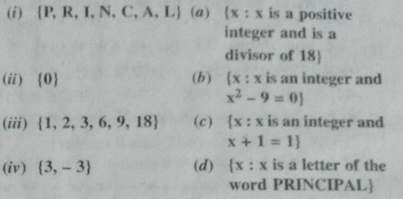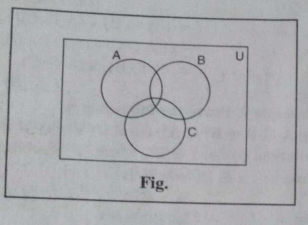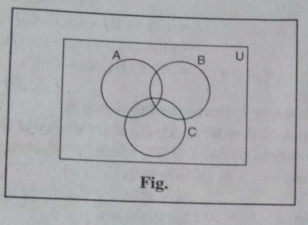Complete Solutions to EXAMPLE of chapter SETS of Class 11 book with complete answers and questions
| Class 11 | MATHS |
| Chapter | SETS |
| MODERN PUBLICATION | EXAMPLE |
| Number Of Questions | 100 |
| Academic Year | 2023-24 |
Explain the difference between a collection and a set. Justify your answer.
View SolutionWrite the set of all vowels in the English alphabet which precede r.
View SolutionWrite the set of all positive integers whose cube is odd.
View SolutionWrite the set of all real numbers , which can not be written as the quotient of two integers in the Set Builder Form.
View SolutionWrite the set `{1/2,2/3,3/4,4/5,5/6,6/7}` in the Set Builder Form.
View SolutionWrite the set {x : x is a positive integer and `x^2 < 40`} in the Roster Form.
View SolutionWrite the set {1, 4, 9, 16, 25, ....} in Set Builder Form.
View SolutionWrite the solution set of the equation : `x^2+x-2=0` in Roster Form.
View SolutionMatch each of the set on the left in the Roster Form with the same set on the right described in the Set Builder form :

View SolutionWhich of the following sets are finite or infinite:- The set of months of a year
View SolutionWhich of the following sets are finite or infinite:- {1,2,3....}
View SolutionWhich of the following sets are finite or infinite:- {1,2, 3,...99, 100}
View SolutionState whether each of the following set is finite or infinite: The set of numbers which are multiple of 5
View SolutionState whether the following set is finite or infinite : The set of prime numbers less than 50.
View SolutionState whether the following set is finite or infinite : The set of positive integers greater than 50.
View SolutionState whether the following set is finite or infinite : The set of concentric circles in a plane.
View SolutionState whether the following set is finite or infinite : A= {x:x `in` N and `x^2-3x+2=0`}
View SolutionState whether the following set is finite or infinite : B= {x:x `in` N and `x^2=9`}
View SolutionState whether the following set is finite or infinite : C= {x:x `in` N and x is even }
View SolutionState whether the following set is finite or infinite : D= {x:x `in` N and 2x-3=0}.
View SolutionWhich of the following are examples of the null set :- Set of odd natural numbers divisible by 2
View SolutionWhether the following is empty (null) set?
{x:x < 5 and x>7, x `in` N}
View SolutionWhether the following is empty (null) set?
{`x:x^2 =25` and x is an odd integer}
View SolutionWhether the following is empty (null) set?
{`x:x^2-2= 0` and x is rational}
View SolutionWhether the following is empty (null) set?
{x:x is common point of any two parallel lines}.
View SolutionWhat is the set : `{x:x in R, x^2=9, 2x=4}` ?
View SolutionFind the pairs of equal sets from the following sets , if any, giving reason : `A={0}, B= {x:x>15 and x<5}`, `C={x:x-5=0}, D ={x:x^2=25}, E={x : x` is an integral positive root of the equation `x^2-2x-15=0`} .
View SolutionAre the following pairs of sets equal ? Give reasons.
A={2,3}, B={x:x is solution of `x^2+3x+2=0`}
View SolutionAre the following pair of sets equal ? Give reasons. A = { x : x is a letter in the word FOLLOW} B = { y : y is a letter in the word WOLF}
View SolutionConsider the following set : `phi, A= {1, 3}, B = {1, 5, 9},C= {1, 3, 5, 7, 9}.` Insert the correct symbol `sub` or `cancel (sub)` between pair of sets : `phi .............. B`.
View SolutionConsider the following set : `phi, A= {1, 3}, B = {1, 5, 9},C= {1, 3, 5, 7, 9}`. Insert the correct symbol `sub` or `cancel (sub)` between pair of sets : A.........B.
View SolutionConsider the following set : `phi, A= {1, 3}, B = {1, 5, 9},C= {1, 3, 5, 7, 9}.` Insert the correct symbol `sub` or `cancel (sub)` between pair of sets : A.........C.
View SolutionConsider the following set : `phi, A= {1, 3}, B = {1, 5, 9},C= {1, 3, 5, 7, 9}.` Insert the correct symbol `sub` or `cancel (sub)` between pair of sets : B.........C.
View SolutionList all the subsets of the set {- 1, 0, 1}.
View SolutionLet A = {p, q, r,s}, B = {p, q, r} and C = {q, s}. Find all sets X such that : `X sub B` and `X sub C`
View SolutionLet A = {p, q, r,s}, B = {p, q, r} and C = {q, s}. Find all sets X such that : `X sub A` and `X cancel (sub) B` .
View SolutionLet A, B and C be three sets. If `A in B` and `B sub C`, is it true that `A sub C` ? If not, give an example.
View SolutionLet A = {1, 2, 3, 4}, B = {1, 2, 3} and C = {2, 4}. Find all sets X satisfying pair of conditions : `X sub B` and `X cancel (sub) C`.
View SolutionLet A = {1, 2, 3, 4}, B = {1, 2, 3} and C = {2, 4}. Find all sets X satisfying pair of conditions : `X sub B, X ne B` and `X cancel (sub) C`.
View SolutionLet A = {1, 2, 3, 4}, B = {1, 2, 3} and C = {2, 4}. Find all sets X satisfying pair of conditions : `X sub A, X sub B` and `X sub C`.
View SolutionProve that `A sub B,B sub C implies A sub C`.
View SolutionLet A = {{1, 2, 3}, {4, 5}, {6, 7, 8}}. Determine whether the following is true or false : `1 in A`
View SolutionLet A = {{1, 2, 3}, {4, 5}, {6, 7, 8}}. Determine whether the following is true or false : `{1, 2, 3} sub A`.
View SolutionLet A = {{1, 2, 3}, {4, 5}, {6, 7, 8}}. Determine whether the following is true or false : `{6, 7, 8} in A`.
View SolutionLet A = {{1, 2, 3}, {4, 5}, {6, 7, 8}}. Determine whether the following is true or false : `{{4, 5}} sub A`.
View SolutionLet A = {{1, 2, 3}, {4, 5}, {6, 7, 8}}. Determine whether the following is true or false : `phi in A`.
View SolutionLet A = {{1, 2, 3}, {4, 5}, {6, 7, 8}}. Determine whether the following is true or false : `phi sub A`.
View SolutionIf A= {1, 2, 3, 4}, B = {3, 4, 5, 6}, C = {5, 6, 7, 8 }and D = { 7, 8, 9, 10 }, find:- `A uu C`
View SolutionIf A= {1, 2, 3, 4}, B = {3, 4, 5, 6}, C = {5, 6, 7, 8 }and D = { 7, 8, 9, 10 }, find:- `B uu C`
View SolutionIf A= {1, 2, 3, 4}, B = {3, 4, 5, 6}, C = {5, 6, 7, 8 }and D = { 7, 8, 9, 10 }, find:- `B uu D`
View SolutionIf A= {1, 2, 3, 4}, B = {3, 4, 5, 6}, C = {5, 6, 7, 8 }and D = { 7, 8, 9, 10 }, find:- `A uu B uu C`
View SolutionIf A= {1, 2, 3, 4}, B = {3, 4, 5, 6}, C = {5, 6, 7, 8 }and D = { 7, 8, 9, 10 }, find:- `A uu B uu D`
View SolutionIf A= {1, 2, 3, 4}, B = {3, 4, 5, 6}, C = {5, 6, 7, 8 } and D = { 7, 8, 9, 10 }, find:- `B uu C uu D`
View SolutionIf `A_1= {2,3,4,5}, A_2={3,4,5,6}, A_3= {4,5,6,7}` , find `uu A_i` and `nn A_i`, where i = {1, 2, 3}.
View SolutionIf A= {3, 6, 9, 12, 15, 18, 21}, B = { 4, 8, 12, 16, 20 }, C = { 2, 4, 6, 8, 10, 12, 14, 16 }, D = {5, 10, 15, 20 }, find:- A-B
View SolutionIf A= {3, 6, 9, 12, 15, 18, 21}, B = { 4, 8, 12, 16, 20 }, C = { 2, 4, 6, 8, 10, 12, 14, 16 }, D = {5, 10, 15, 20 }, find:- B-C
View SolutionIf A= {3, 6, 9, 12, 15, 18, 21}, B = { 4, 8, 12, 16, 20 }, C = { 2, 4, 6, 8, 10, 12, 14, 16 }, D = {5, 10, 15, 20 }, find:- C-D
View SolutionIf A= {3, 6, 9, 12, 15, 18, 21}, B = { 4, 8, 12, 16, 20 }, C = { 2, 4, 6, 8, 10, 12, 14, 16 }, D = {5, 10, 15, 20 }, find:- D-C
View SolutionIf U = { a, b, c, d, e, f, g, h}, find the complements of the following set : A = {a, b, c}
View SolutionIf U = { a, b, c, d, e, f, g, h}, find the complements of the following set : B={d, e, f, g}
View SolutionIf U = { a, b, c, d, e, f, g, h}, find the complements of the following set : C = {a, c, e, g}
View SolutionIf U = { a, b, c, d, e, f, g, h}, find the complements of the following set : D = {f, g, h, a}
View SolutionIf U = {1, 2, 3, 4, 5, 6}, A = {1, 2}, B = {3, 4, 5}, find `A^(c), B^(c), A^(c) nn B^(c)` and `A uu B`.
View SolutionLet U = {1, 2, 3, 4, 5, 6, 7, 8, 9}, A = {1, 2, 3, 4}, B = {2, 4, 6, 8}. Find : `A^(c)`.
View SolutionLet U = {1, 2, 3, 4, 5, 6, 7, 8, 9}, A = {1, 2, 3, 4}, B = {2, 4, 6, 8}. Find : `B^(c)`.
View SolutionLet U = {1, 2, 3, 4, 5, 6, 7, 8, 9}, A = {1, 2, 3, 4}, B = {2, 4, 6, 8}. Find : `(A^(c))^(c)`.
View SolutionLet U = {1, 2, 3, 4, 5, 6, 7, 8, 9}, A = {1, 2, 3, 4}, B = {2, 4, 6, 8}. Find : `(A uu B)^(c)`.
View SolutionIf U ={x: x is a letter in Engtish alphabet} A={x : x is a vowel in English alphabet}. Find `A^(c)` and `(A^(c))^(c)`.
View SolutionLet U = {1,2,3,4,5, 6,7, 8, 9, 10}, A = {1, 3, 5}, B = {2, 4, 6}, C = {4, 5, 6}. Find `A^(c) nn B^(c)`
View SolutionLet U = {1,2,3,4,5, 6,7, 8, 9, 10}, A = {1, 3, 5}, B = {2, 4, 6}, C = {4, 5, 6}. Find `(A uu B)^(c) nn C^(c)`.
View SolutionLet A = {1, 2, 3, 4, 5, 6} B = {3, 4,5, 6, 7, 8}. Find `(A-B) uu (B -A)`.
View SolutionIf U = {1, 2, 3, 4, 5, 6, 7, 8, 9}, A = {1,2,3,4}, B= {2, 4, 6,8} and C= {3,4,5 ,6}. Find : `A^(c)`.
View SolutionLet U = { 1, 2, 3, 4, 5, 6, 7, 8, 9 }, A = { 1, 2, 3, 4}, B = { 2, 4, 6, 8 } and C = { 3, 4, 5, 6 }. Find:- B'
View SolutionLet U = { 1, 2, 3, 4, 5, 6, 7, 8, 9 }, A = { 1, 2, 3, 4}, B = { 2, 4, 6, 8 } and C = { 3, 4, 5, 6 }. Find:- `(A uu C)' `
View SolutionLet U = { 1, 2, 3, 4, 5, 6, 7, 8, 9 }, A = { 1, 2, 3, 4}, B = { 2, 4, 6, 8 } and C = { 3, 4, 5, 6 }. Find:- `(A uu C)' `
View SolutionLet U = { 1, 2, 3, 4, 5, 6, 7, 8, 9 }, A = { 1, 2, 3, 4}, B = { 2, 4, 6, 8 } and C = { 3, 4, 5, 6 }. Find:- (A')'
View SolutionLet U = { 1, 2, 3, 4, 5, 6, 7, 8, 9 }, A = { 1, 2, 3, 4}, B = { 2, 4, 6, 8 } and C = { 3, 4, 5, 6 }. Find:- (B -C)'
View SolutionIf U ={1,2, 3, 4, 5, 6, 7, 8, 9 }, A = {2, 4, 6, 8} and B = { 2, 3, 5, 7}. Verify that `(A uu B)' = A' nn B'`
View SolutionIf U ={1,2, 3, 4, 5, 6, 7, 8, 9 }, A = {2, 4, 6, 8} and B = { 2, 3, 5, 7}. Verify that `(A nn B)' = A' uu B'`
View SolutionIf A = {1, 2, 3}, B= { 4, 5, 6} and C= { 7, 8, 9}, verify that : `A uu (B nn C)= (A uu B) nn (A uu C)`.
View SolutionIf `A nn B^(c)= phi`, show that `A sub B`.
View SolutionIf A and B are any two sets, prove that : `A-B =A nn B^(c)`.
View SolutionIf A and B are any two sets, prove that : `(A-B) uu B =A uu B`.
View SolutionShow that : `(A uu B)-(A nn B) = (A -B) uu (B-A)`.
View SolutionIf A, B and C are any three sets, then prove that : `A nn (B-C) = (A nn B)-(A nn C)`.
View SolutionIf A, B and C are any three sets, then prove that : `A nn (B Delta C) = (A nn B) Delta (A nn C)`.
View SolutionProve the following : `A sub B iff B^(c) sub A^(c)`.
View SolutionProve the following : `B sub A implies A uu B=A`.
View SolutionProve the following : `A-B=A-(A nn B)`.
View SolutionProve the following : `U -(U - A) = (A^(c))^(c)=A`, where U is the universal set.
View SolutionShade the following : `A^(c) nn (B uu C)` in the given Venn diagram.

View SolutionShade the following : `A^(c) nn (C-B)` in the given Venn diagram.

View SolutionIf X and Y are two sets such that n ( X ) = 17, n ( Y ) = 23 and `n(X uu Y) = 38`, find `n(X nn Y)`.
View SolutionA and B are two sets containing respectively `m_1` and `m_2` elements. If `x le n(A uu B) le y`, find x and y.
View SolutionIf A and B be two sets containing 6 and 3 elements respectively, what can be the minimum number of elements in `AuuB` ? Also, find the maximum number of elements in `AuuB`.
View SolutionTwo finite sets have m and n elements. The total number of subsets of the first set is 56 more than the total number of subsets of the second set. Find the values of m and n.
View SolutionOut of 20 members in a family, 11 like to take tea and 14 like coffee. Assume that each one likes at least one of the two drinks. How many like : both tea and coffee?
View SolutionThere are 20 students in a Chemistry class and 30 students in a Physics class. Find the number of students which are either in Physics class or Chemistry class in the following case : the classes meet at the same hour.
View SolutionThere are 20 students in a Chemistry class and 30 students in a Physics class. Find the number of students which are either in Physics class or Chemistry class in the following case : the two classes meet at different hours and ten students are rolled in both the subjects.
View SolutionIn a survey of 400 students in a school, 100 were listed as drinking apple juice, 150 as drinking orange juice and 75 were listed as both drinking apple as well as orange juice. Find how many students were drinking neither apple juice nor orange juice.
View Solution
EXAMPLE questions and complete solutions for chapter SETS of MODERN PUBLICATION of Class 11